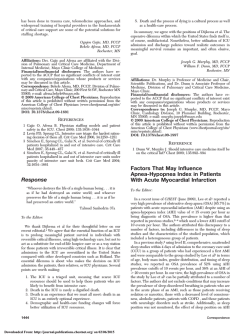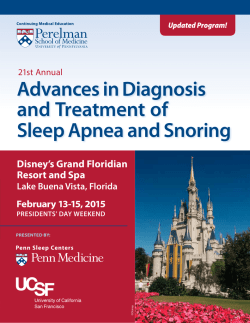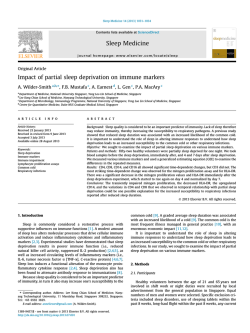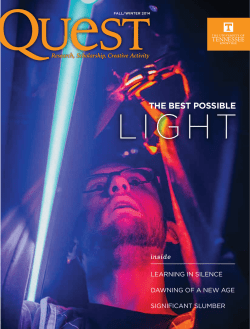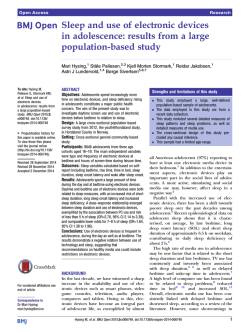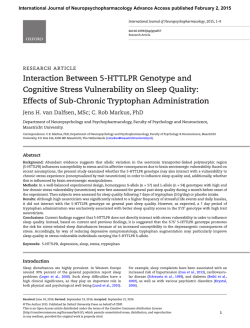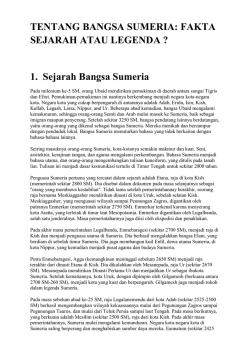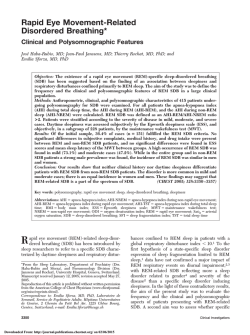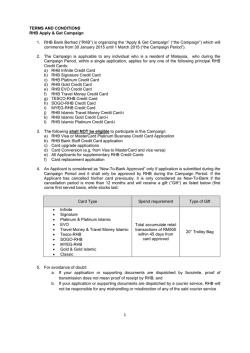
Download (214kB)
BAB 6 SIMPULAN DAN SARAN 6.1 Simpulan Profil pasien OSA di RS PHC Surabaya tahun 2013 adah sebagai berikut. 6.1.1 Sosiodemografi Paling banyak pasien OSA berumur 51-60 tahun (31%) dan jenis kelamin terbanyak adalah laki-laki (84%). 6.1.2 Faktor Risiko OSA IMT pasien OSA terbanyak ada dalam kategori obesitas (IMT ≥ 30) dan pre-obes (IMT 25,0-29,9) yaitu 36%. 6.1.3 Manifestasi Klinis Mendengkur dialami oleh semua pasien (100%), excessive daytime sleepiness dialami 84% pasien dan yang mengalami apnea saat tidur 76%. 6.1.4 Co-morbid Pasien OSA yang memiliki co-morbid hipertensi sebanyak 31% dan yang memiliki co-morbid DM tipe 2 sebanyak 15%. 6.1.5 Indikator Derajat Keparahan Pasien OSA paling banyak di kelompok AHI yang berat (39%). Pasien OSA saat tidur yang mengalami saturasi O2 ≤ 94% lebih sedikit dibandingkan yang mengalami > 94%. Tabulasi silang umur menurut AHI 69 didapatkan umur 51-60 tahun paling banyak yang mengalami AHI berat. Tabulasi silang IMT menurut AHI didapatkan semakin tinggi IMT cenderung semakin besar AHInya. Tabulasi silang saturasi O2 menurut AHI didapatkan pasien paling banyak pada AHI berat dengan saturasi O2 ≤ 94%. 6.2 Saran 6.2.1 Bagi Pendidikan Kedokteran Bagi mahasiswa kedokteran yang masih menempuh pendidikan strata-1, diharapkan dapat mempelajari dengan lebih baik tentang gejala, faktor risiko, indikator derajat keparahan, dan ko-morbid OSA. Pemberian informasi dan edukasi yang lebih optimal lagi pada masyarakat. 6.2.2 Bagi Rumah Sakit Pemberian edukasi atau penyuluhan kesehatan dapat dijadikan program rutin bagi rumah sakit baik di poli THT maupun di ruang perawatan, jika perlu dilakukan pada masyarakat awam. Perlu dilengkapi media promosi kesehatan agar penyuluhan yang dilakukan mudah dipahami. Media yang bisa digunakan seperti brosur, memasang spanduk dan poster-poster terkait dengan gejala, pencegahan dan ko-morbid OSA. 6.2.3 Bagi Penelitian Sebagai dasar untuk penelitian selanjutnya, dapat ditingkatkan menjadi penelitian analitik, baik tentang faktor-faktor risiko OSA, hubungan mendengkur atau saturasi oksigen terhadap faktor-faktor tersebut 70 atau dengan AHI. Sampel dapat ditingkatkan lebih banyak dan waktu yang lebih panjang. 71 DAFTAR PUSTAKA Alan, R., et al. 2008. Obesity and Obstructive Sleep Apnea, Proceedings of the American Thoracic Society, Vol. 5, No. 2, pp. 185-192. American Academy of Sleep Medicine. 2008. Obstructive sleep apnea. Retrieved June 25, 2014 from http://www.aasmnet.org/resources/factsheets/sleepapne a.pdf. Auckley, D., et al. 2007. Finding of a Berlin questionnaire survey: comparison between patients seen in asthma clinic versus internal medicine clinic. Sleep Med.;30:1-6. Brunner, L.S. & D.S. Suddarth. 2002. Buku Ajar Keperawatan Medikal Bedah (vol 2). (H. Kuncara, A. Hartono, M. Ester, Y. Asih, penerjemah). Jakarta: EGC. Buxbaum, S.G., et al. 2002. Genetics of the Apnea Hypopnea Index in Caucasians and African Americans: I. Segregation Analysis. Genet Epidemiol 2002; 22:243-53. Chung, F., et al. 2008. Validation of the berlin questionnaire and american society of anesthesiologists checklist as screening tools for obstructive sleep apnea in surgical patients. Anesthesiology, 5(108): 822-21. Dincer, H.E. & W. O'Neill. 2006. Deleterious effects of sleep-disordered breathing on the heart and vascular system. Respiration; 73: 124-30. Douglas, N.J. 2008 Sleep Apnea. In: Fauci AS, Braunwald E, Kasper DL, et al (eds).. Harrison’s Principles of Internal Medicine. 17th ed. USA: McGraw Hill .pp:1665-8. Duran, J., et al. 2001. Obstructive Sleep Apnea-Hypopnea and Related Clinical Features in a Population-Based Sample of Subject Aged 30 to 70 yr. Am J Respir Crit Care Med 2001; 163: 685-89. Engleman, H.M. & N.J. Douglas. 2004. Sleepiness, cognitive function and quality of life in obstructive sleep apnoea/hypopnoea syndrome. Thorax 2004; 59: 618-22. 72 European Respiratory Task Force. 2002. Public health and medicolegal implications of sleep apnoea. Eur Respir J 2002; 20: 1594-609. Febriani, D., dkk. 2011. Relationship between obstructive sleep apnea and cardiovascular.J Kardiol Indones 2011;32:45-52. Fogel, R.B., et al. 2004. Patophysiology of obstructive apnoea/hypopnoea syndrome. Thorax 2004; 59: 159-63. sleep Gami, A.S., et al. 2003. Obesity and obstructive sleep apnea. Endocrinol Metab Clin North Am;32:869-73.15 Gami, A.S. & V.K. Somers. 2008. Sleep Apnea and Cardiovascular Disease. In: Libby P, Bonow RO, Mann DL, Zipes DP (eds). 2008. Braunwald’s Heart Disease A Textbook of Cardiovascular Medicine. 8th ed. Philadelphia: Saunders Elsevier. pp: 1915-21. Gibson, G.J. 2005. Obstructive sleep apnoea syndrome: underestimated and undertreated. Brit Med Bulletin 2005; 72: 49-64. Guyton, A.C. & J.E. Hall. 2008. Buku Ajar Fisiologi Kedokteran. Edisi 11. Editor Irawati Setiawan, Et al. Jakarta : EGC. Hal 778-80. Hailani, I. 2012. Obstructive Sleep Apnoea. retrieved: January 20, 2014, from: http://www.myhealth.gov.my/index.php /obstructive-sleepapnoea. Hamilton, G.S., et al. 2004. Obstructive Sleep Apnoea and Cardiovascular Disease. Intern. Med. J. ; 34: 420–6. Hoffstein, V. 2000. Snoring and nocturnal oxygenation: is there a relationship? Chest.;108:370-4 Hungu. 2007. Demografi Kesehatan Indonesia. Jakarta: Grasindo. Ip, M.S., et al. 2001. A Community Study of Sleep-Disordered Breathing in Middle-Aged Chinese Men in Hong Kong. Chest 2001; 119:62-9. 73 Kabo, P. 2010. Bagaimana Menggunakan Obat-Obat Kardiovaskular Secara Rasional. Jakarta: Balai Penerbit Fakultas Kedokteran Universitas Indonesia. Kotecha, B. & J.M. Shneerson. 2003. Treatment options for snoring and sleep apnoea. Journal of The Royal Society of Medicine 2003; 96: 343 – 4. Kozier, dkk. 2010. Buku Ajar Fundamental Keperawatan: Konsep, Proses, dan Praktik. (edisi 7 volume 1). Jakarta: EGC. Kryger, M.H., et al. 2005. Principles and Practice of Sleep Medicine. 4th ed. Philadelphia: Saunders Elsevier. Kushida, C.A. 2007. Obstructive sleep apnea diagnosis and treatment.New York: Informa Healthcare USA, inc. Lindberg, E., et al. 1998. A 10-year follow-up of snoring in men. Chest; 114: 1048-55. Malhotra, A. & D.P. White. 2002. Obstructive sleep apnea. Retrieved: February 3, 2014, from: http://www.ncbi. nlm.nih.gov/pubmed/12133673. Garcia, M.A., et al. 2003 Clinical predictors of sleep apnea-hypopnea syndrome susceptible to treatment with Continuous positive airway pressure. Arch Bronconeumol; 39(10):449–454 McArdle, N., et al. 2007. Metabolic risk faktors for vaskular disease in obstructive sleep apnea. Am J Respir Crit Care Med;175:190-5.18. MedicineNet. 2012. Definition of excessive daytime sleepiness. Retrieved June 22, 2014, from http://www.medterms.com/script/main/art.asp? articlekey=10472 MedicineNet. 2013. Definition of sleep apnea. Retrieved June 22 2014, from http://www.medterms.com/script/main/art.asp?articlekey=5510. 74 Netzer, N.C., et al. 1999. Using the Berlin questionnaire to identify patients at risk for the sleep apnea syndrome. Ann Intern Med; 131(7):485– 491. Newman, et al. 2005. Progression and regression of sleep-disordered breathing with changes in weight: the sleep heart health study. Arch Intern Med;165:2408–2413. Nieto, F.J., et al. 2000. Association of sleep-disordered breathing, sleep apnea and hypertension in a large community-based study. Sleep Heart Health Study. JAMA 2000; 283: 1829-36. Notoatmodjo, S. 2010. Ilmu Perilaku Kesehatan. Jakarta : PT Rineka Cipta. Parish J.M. & V.K. Somers. 2004. Obstructive sleep apnea and cardiovascular disease. Mayo Clin Proc 2004; 79: 1036-46. Pillar, G., et al. 2010. Principles and Practice of Geriatric Sleep Medicine. Cambridge University Press, 2010. New York. page 75-82. Poerwadarminta, W.J.S. 2003. Kamus Umum Bahasa Indonesia. Jakarta: Balai Pustaka. Rachman, A. 2007. Mendengkur “The Silent Killer” dan Upaya Penanganannya dalam meningkatkan kualitas hidup. Medan, Sulawesi Utara. Ryan, C.M., & T.D. Bradley. 2005. Pathogenesis of Obstructive Sleep Apnea. J Appl Physiol 2005; 99: 2440-50. Saragih, A.R. 2007. Mendengkur “the silent killer” dan upaya penanganannya dalam meningkatkan kualitas hidup. Medan: Universitas Sumatera Utara. Hal. 1 -13. Sastroasmoro, S. & S. Ismael. 2011. Dasar-dasar Metodologi Penelitian Klinis (edisi 4). Jakarta: CV Sagung Seto. Schlosshan, D. & W. Elliot. 2004. Clinical presentation and diagnosis of the obstructive sleep apnoea hypopnoea syndrome. Thorax 2004; 59: 347-52. 75 Seneviratne, U. & K. Puvanendran. 2004. Excessive daytime sleepiness in obstructive sleep apnea: prevalence, severity, and predictors. Sleep Med; 5(4):339–343. Sharma, S.K., et al. 2006. Validation of the modified berlin questionnaire to identify patients at risk for the obstructive sleep apnoea syndrome. Indian J Med Res 124:281-290. Shamsuzzaman, A.S., et al. 2003. Obstructive sleep apnea: implications for cardiac and vascular disease. JAMA 2003; 290: 1906-14. Simposium Mendengkur dan Obstructive Sleep Apnea (OSA), Another Silent Killer. 2007, nov 15. Retrieved January 16, 2014, from http://medicastore.com/index.php?mod=printPage&page=seminar& id=45. Teodorescu, M., et al. 2006. Correlates of daytime sleepiness in patients with asthma. Sleep Medicine.;7:607-13 The National heart lung and blood institute diseases and conditions index: sleep apnea. 2009. Retrieved: February 4, 2014, from: http://www.nhlbi.nih.gov/ health/dci/Diseases/SleepApnea/SleepApnea_WhatIs.html. Tjokroprawiro, A., 2007. Buku ajar ilmu penyakit dalam. Surabaya: Airlangga University Press. Wael, et al. 2002. Snoring as a Risk Factor for Type II Diabetes Mellitus: A Prospective Study. Am. J. Epidemiol. 155 (5):387-393. Wessendorf, T.E., et al. 2000. Sleep-disordered breathing among patients with first-ever stroke. J Neurol 2000; 247: 41-7. White, D.P. 2006. The pathogenesis of obstructive sleep apnea: advances in the past 100 years. Am J Respir Cell Mol Biol 2006; 34: 1-6. WHO. 2014. Obesity and overweight. Retrieved June 22, 2014, from http://www.who.int/mediacentre/factsheets/fs311/en/. 76 WHO. 2014. Stroke, cerebrovascular accidents. Retrieved June 22, 2014, from http://www.who.int/topics/cerebrovascular_accident/en/. Wolkove, N., et al. 2007. Sleep and aging: Sleep disorders commonly found in older people. Can Med Assoc J 2007; 176(9): 1299-303. Young, T., et al. 1997. Estimation of the clinically diagnosed proportion of sleep apnoea syndrome in middle-aged men and women. Sleep 1997; 20: 705-6. Young, T., et al. 2002. Predictors of Sleep-Disordered Breathing in Community-Dwelling Adults: The Sleep Heart Health Study. Arch Intern Med 2002; 162: 893-900. Young, T., et al. 2004. Risk Factors for Obstructive Sleep Apnea in Adults. JAMA 2004; 291: 2013-16. Yuan. 2007. Mendengkur Bisa Membunuh Diam-Diam. Retrieved: February 5, 2014, from: http://www.dechacare.com /MendengkurBisa-Membunuh-Diam-diam-I89.html. 77
© Copyright 2025
